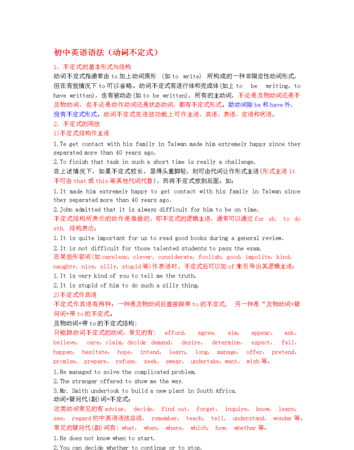本文目录
初二上册英语动词不定式大全
1、to
+动词原形
2、省略to的不定式
如:let
sb
do
help
sb
do
make
sb
do
3、不定式可以做宾语、状语、补语、表语、定语、主语。动词不定式概述
一
不定式的体
1.
不定式的一般式(to
do)表示不定式的.动作将要发生或与谓语动作同时发生.
2
不定式的进行体(to
be
doing)表示不定式的动作正在发生.
不定式的完成体(to
have
done)表示不定式的动作在谓语动作之前发生.
二
不定式的逻辑主语
1
不定式的逻辑主语常不出现在句中.
2
句子的主语,宾语有时是不定式的逻辑主语.
3
不定式前"for+名词/代词"结构中的名词或代词也可以用来表示不定式的;逻辑主语.
4
在"It+be+形容词+of+名词/代词+to
do"结构中,名词或代词为不定式的逻辑主语.该结构中的形容词通常用来表示人的品质.例如:kind,
good,
nice,
bad,
cruel,
honest,
bold,
thoughtful,
right,
wrong,
wise,
clever,
silly,
foolish,
careless,
rude等.
例如:It's
very
kind
of
you
to
cal
to
tell
me
about
the
conference.
三
不定式的否定式
不定式否定式由not/never
+to
do构成
四
不定式的句法功能
1
不定式做主语
1)To
say
something
is
one
thing;
to
do
it
is
another.
2)It
is
not
a
good
idea
to
build
houses
along
the
lines
where
two
of
the
earth's
plates
join
together.
注:充当主语的不定式即可置于句首,位于谓语动词之前,也可作为句子的真正主语置于句末,用作形式主语.
2
不定式作表语
3)Her
uncle
seems
to
be
acting
rather
strangely
towards
her
these
days.
4)The
purpose
of
the
fence
is
to
keep
out
a
type
of
wild
dog
called
a
"Dingo".
5)One
suggested
answer
is
for
farmers
to
limit
the
number
of
their
cattle.
注:充当表语的不定式一般位于be
,seem等系动词后.
3
不定式作宾语
6)Shylock
agreed
to
lend
Antonio
money
on
one
condition.
注:充当宾语的不定式位于及物动词后.常用不定式作宾语的动词有:agree,
plan,
determine,
dare,
refuse,
hope,
wish,
expect,
promise,
choose,
pretend,
decide,
manage,
intend,
offer,
afford,
demand.
7)The
dusty
air
makes
it
difficult
to
get
a
clear
picture
of
space.
注:充当宾语的不定式如果有自己的表语,则可用代替只个不定式作为形式宾语,而作为真正宾语的不定式则放在表语之后.以it作为形式宾语的这种结构常用在think,
feel,
find,
make,
consider等动词之后.
big
and
strong.
4
不定式作宾语补足语
8)The
powder
made
from
fish,
blood
and
bones
will
make
the
cabbage
plants
grow
big
and
strong.
9)Portia
told
Bassanio
to
go
to
his
friend
at
once.
注:在下列动词后作宾语补足语的不定式通常不带to.这些动词是observe,
notice,
see,
hear,
watch,
have,
feel,
make,
let.但上述动词转换为被动语态时,其后的不定式须带to.例如:The
cabbage
plants
will
be
made
to
grow
动词不定式(todo)是初中英语课的一个重点,也是中考要考查的一个项目。动词不定式属于非谓语动词的一种形式,很多同学经常把它和谓语动词混在一起,掌握起来有困难。下面我们对动词不定式的用法做简单归纳,帮助同学们记忆:

英语中后跟动词不定式的动词
有些动词后接宾语时,既可接不定式,又可接动名词,但有区别。如
1. like to do “喜欢做某事”,指一次性动作。如 I like to swim in this river now.
like doing “喜欢做某事”,指习惯性动作。如 I like swimming.
类似的还有:dislike to do / doing (“不喜欢做某事”), hate to do / doing (“讨厌做某事”),
love to do / doing (“热爱做某事”), prefer to do / doing (“更喜欢做某事”)。
2. remember to do “记得要去做某事” 如 She remembered to see her parents the next day.
remember doing “记得做过某事” 如 I remembered meeting her yesterday.
3. forget to do “忘了要去做某事” 如 They always forget to have lunch when they are busy.
forget doing “忘了做过某事” 如 I forgot phoning Tom, so I phoned him the second time.
4. try to do “试图(尽力)做某事” 如 He tried to catch the early bus and he got on it at last.
try doing “试图(试着)做某事” 如 I tried getting on well with the new students.
5. mean to do “打算做某事” 如 Jack meant to help others.
mean doing “意味着做某事” 如 Drinking means wasting your life.
6. need to do “需要做某事” (主语必须是人) 如 We need to have a rest.
need doing “需要做某事”(主语必须是物) 如 The bike needs mending. ( = The bike needs to be mended)
7. want to do “想要做某事” (主语必须是人) 如 We want to have a rest.
want doing “想要做某事”(主语必须是物) 如 The bike wants mending. ( = The bike wants to be mended)
8. begin to do与begin doing 都译作“开始做某事”,二者可以混用。但是begin doing更强调动作不但开始,而且一直持续下去。如 The baby began crying hard.
而在下类情况下只用begin to do, 不用begin doing:
○1当主语是物时。如 It began to snow.
○2当begin用进行时的时候。如 The train is beginning to leave.
○3当begin后接表示心理活动的动词(如think, understand, know)时。如 She began to understand her parents.
注:begin的用法完全适用于start。
9. go on to do “继续做某事”,指做不同的事。
如 After reading English, she went on to learn math.
go on doing “继续做某事”,指做同一件事,相当于_go on with sth 。
如 When I was writing a letter, someone knocked at the door. I opened the door and then went on writing the letter (= …went on with the letter).
10. continue to do “继续做某事”,指做不同的事。
如 After reading English, she continued to learn math.
continue doing “继续做某事”,指做同一件事。
如 When I was writing a letter, someone knocked the door. I opened the door and then continued writing the letter.
11. be used to do “被用来做某事” 如 Dictionaries are used to look up words.
be used to doing “习惯于做某事” 如 He is used to exercising in the morning.
希望能够帮到你,望采纳!

初中英语动词不定式归纳
一、动词不定式的复合结构
动词不定式的复合结构是“for / of sb. to do sth.”,for / of引出不定式动作的逻辑主语。这种结构在句子中可以作主语、宾语、表语、定语、状语等。不定式复合结构的介词用for还是of,主要决定于前面形容词的性质。一般说来,of前面的形容词是careful, clever, foolish, good, kind, nice, wise等,既说明人的特性,又说明不定式动作的特性。for前面的形容词是dangerous, difficult, easy, hard, heavy, important, interesting, necessary等,一般说明不定式动作的特性,不说明人的特性。前面如果是名词用for。如:
1.Its also probably a good idea for parents to allow teenagers to study in groups during the evening. (p.22)
2.Zoos are terrible places for animals to live.(p.120)
二、带疑问词的不定式短语
动词不定式前面可以带疑问代词what, which, who或疑问副词how, when, where, why等。这种结构起名词的作用,在句子里用作宾语、主语、表语等,或者单独使用。要注意的是,why后面的不定式不带to。如:
1.用作句子的成分。
1)I don’t know what to try next. (p.49)(作宾语)
2)Where to go is not decided yet.(作主语)
2.单独使用时相当于一个特殊疑问句。
1)What to do next?(=What will we / you do next?)
2)Why go there?(=Why do we / you go there?)
三、动词不定式的否定式
不定式的否定式是not / never to do...,不带to的不定式的否定式是not / never do...如:
1.Sometimes they have disagreements, and decide not to talk to each other.(p.8)
2.His parents tell him never to drive after drinking.

初中英语动词不定式的用法
使役动词后一般加do,如make,let等。当动词短语为介词时,后加doing,如give
one's
life
to,至于直接加to
do或doing的动词就很多了,初中阶段只要记住一些常用的就好(最好在记一些高中的)

以上就是关于初中英语动词不定式总结 ,初二上册英语动词不定式大全的全部内容,以及初中英语动词不定式总结 的相关内容,希望能够帮到您。
